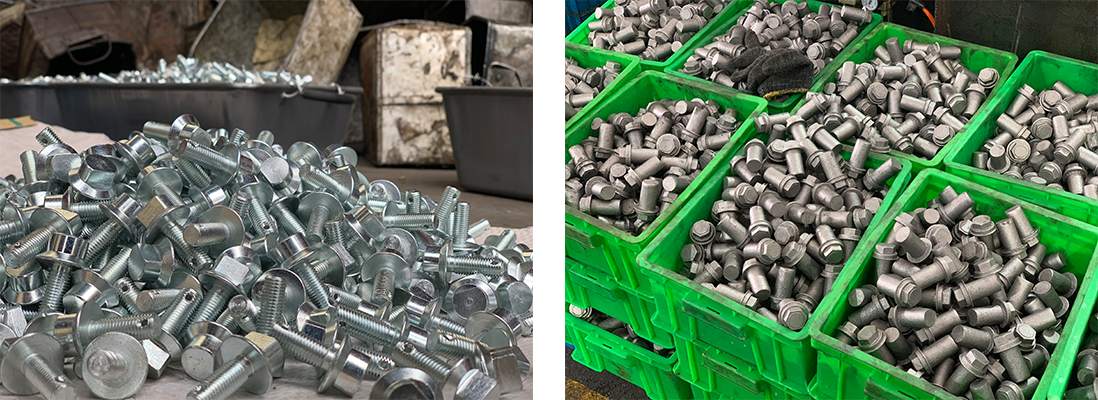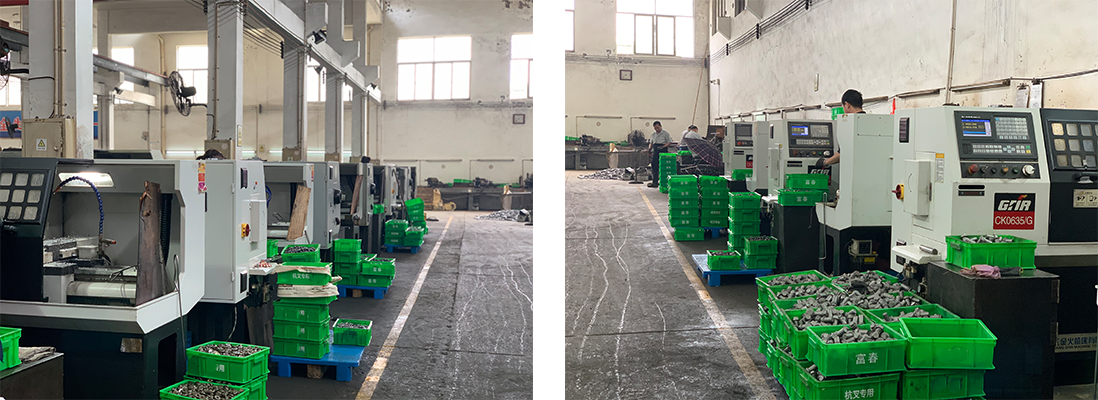- All
- Product Name
- Product Keyword
- Product Model
- Product Summary
- Product Description
- Multi Field Search
Views: 36 Author: Site Editor Publish Time: 2019-06-17 Origin: www.fuchun-casting.com
Fasteners are a kind of mechanical parts which are widely used for fastening connections. A variety of fasteners can be seen on various machinery, equipment, vehicles, ships, railways, bridges, buildings, structures, tools, instruments, instruments and supplies.
Fasteners in almost all industries are made of carbon steel and alloy steel. Some kinds of fasteners hope to prevent corrosion. Even if fasteners with anticorrosive materials are used, proper surface treatment is still needed to prevent corrosion of different materials.

Steel fasteners can be electro-plated with zinc for better corrosion resistance and usually to a thickness of 200 – 300 micro inches (.0002" - .0003"). Fasteners that have been zinc plated have a shiny silver finish. It is a sacrificial finish that by forming a “galvanic cell” corrodes before the underlying steel. Zinc plated fasteners are fairly corrosion resistant but will rust over time and quicker if the coating is damaged or if exposed to harsh elements (eg marine environments). Plating of this kind will probably provide no more than 12 hours of salt spray protection. The corrosion resistance of zinc depends on the thickness of the coating and can be further increased by applying a conversion coating. A zinc finish also provides some esthetic value, increases abrasion resistance and provides a excellent bonding surface for painting.
Phosphating also known as Parkerization, is a chemical phosphate conversion coating process whereby a microscopic layer of iron is removed and replaced with a comparably thin layer of either zinc or manganese dioxide to make the steel substrate more corrosion and wear resistant. The final result is an attractive and durable grey-black finish. The Parkerizing process is not possible with non-ferrous metals such as aluminum, brass, or copper. Nor can it be applied to steels containing large amounts of nickel, or on stainless steel. Black phosphate coating is often used to enhance corrosion resistance. However, phosphate coating by itself does not provide protection because of the porous nature of the coating.
Therefore, additional treatment with oil or other sealers are used to attain a moderate level of corrosion resistance.
Phosphate coatings are typically used to help break in components subject to wear and help prevent galling. It is also used to prepare surfaces for further coating and/or painting. The porous nature of the phosphate finish allows materials to seep into the coating thereby providing an excellent adhesion base for secondary treatments. Furthermore the chemical nature of the coating electrically isolates the surface of the part which reduces corrosion that tends to occurs at the metal and paint/coating interface.
Cadmium plating provides excellent corrosion resistance even in harsh environments (eg salt atmospheres). It provides good paint base due to excellent paint adhesion properties, and it is more resistant to stripping than zinc plating.
Cadmium is also excellent for plating stainless steel, and with aluminum to prevent galvanic corrosion. Cadmium plating is generally bright silvery white in appearance. Further treating can produce an iridescent, black, golden, amber or olive appearance and increase corrosion resistance.
Chrome is used in plating fasteners primarily for esthetics purposes. It provides comparable corrosion resistance to zinc plating, but at a much higher cost. If more corrosion resistance is required stainless steel may be chrome plated,preventing any corrosion should the chrome be damaged.
Depending on the process used and intended application, nickel can be deposited soft or hard, dull or bright. Nickel plating is often applied for a decorative finish. Bright nickel plating is a highly reflective finish similar to stainless steel, but is very hard with relatively poor ductility. Therefore, parts should be formed into final shape before being plated with bright nickel. Soft nickel plating (semi-bright or dull nickel) has a more satiny finish than does bright nickel, and is more ductile.
Items that may undergo heat shock or minor bending should be plated with soft nickel to reduce the possibility of the plating peeling or flaking off.
Nickel plating on fasteners is mainly used in places where corrosion protection and good conductivity are required.
Hot-dip galvanizing of fasteners are carbon steel fasteners into the heat of approximately 510 ° c dissolves zinc plated tank so that fastener on the surface of Fe-Zn alloy into the passivation of zinc, resulting in surface treatments. Fasteners of hot-dip galvanized price is higher than that of electroplating.
There is no hydrogen embrittlement problem. Without considering the environmental protection of hexavalent chromium, it is actually most suitable for high strength fasteners with high anticorrosion requirements.
Fasteners, as one of the products with large import and export volume in China, are of great practical and strategic significance to promote Chinese firms to enter the world and to promote their full participation in international cooperation and competition.

This is where a batch of steel meets more than one specification or grade. It is a way of allowing melting shops to produce stainless steel more efficiently by restricting the number of different types of steel. The chemical composition and mechanical properties of the steel can meet more than one grade within the same standard or across a number of standards. This also allows stockholders to minimise stock levels.
For example, it is common for 1.4401 and 1.4404 (316 and 316L) to be dual certified - that is the carbon content is less than 0.030%. Steel certified to both European and US standards is also common.
There are many different types of surface finish on stainless steel. Some of these originate from the mill but many are applied later during processing, for example polished, brushed, blasted, etched and coloured finishes.
The importance of surface finish in determining the corrosion resistance of the stainless steel surface cannot be overemphasised. A rough surface finish can effectively lower the corrosion resistance to that of a lower grade of stainless steel.
Various types of stainless steel are used across the whole temperature range from ambient to 1100 deg C. The choice of grade depends on several factors:
In the European standards, a distinction is made between stainless steels and heat-resisting steels. However, this distinction is often blurred and it is useful to consider them as one range of steels.
Increasing amounts of Chromium and silicon impart greater oxidation resistance. Increasing amounts of Nickel impart greater carburisation resistance.
Austenitic stainless steels are extensively used for service down to as low as liquid helium temperature (-269 deg C). This is largely due to the lack of a clearly defined transition from ductile to brittle fracture in impact toughness testing.
Toughness is measured by impacting a small sample with a swinging hammer. The distance which the hammer swings after impact is a measure of the toughness. The shorter the distance, the tougher the steel as the energy of the hammer is absorbed by the sample. Toughness is measured in Joules (J). Minimum values of toughness are specified for different applications. A value of 40 J is regarded as reasonable for most service conditions.
Steels with ferritic or martensitic structures show a sudden change from ductile (safe) to brittle (unsafe) fracture over a small temperature difference. Even the best of these steels show this behaviour at temperatures higher than -100 deg C and in many cases only just below zero.
In contrast austenitic steels only show a gradual fall in the impact toughness value and are still well above 100 J at -196 deg C.
Another factor in affecting the choice of steel at low temperature is the ability to resist transformation from austenite to martensite.
It is commonly stated that “stainless steel is non-magnetic”. This is not strictly true and the real situation is rather more complicated. The degree of magnetic response or magnetic permeability is derived from the microstructure of the steel. A totally non-magnetic material has a relative magnetic permeability of 1. Austenitic structures are totally non-magnetic and so a 100% austenitic stainless steel would have a permeability of 1. In practice this is not achieved. There is always a small amount of ferrite and/or martensite in the steel and so permeability values are always above 1. Typical values for standard austenitic stainless steels can be in the order of 1.05 – 1.1.
It is possible for the magnetic permeability of austenitic steels to be changed during processing. For example, cold work and welding are liable to increase the amount of martensite and ferrite respectively in the steel. A familiar example is in a stainless steel sink where the flat drainer has little magnetic response whereas the pressed bowl has a higher response due to the formation of martensite particularly in the corners.
In practical terms, austenitic stainless steels are used for “non-magnetic” applications, for example magnetic resonance imaging (MRI). In these cases, it is often necessary to agree a maximum magnetic permeability between customer and supplier. It can be as low as 1.004.
Martensitic, ferritic, duplex and precipitation hardening steels are magnetic.